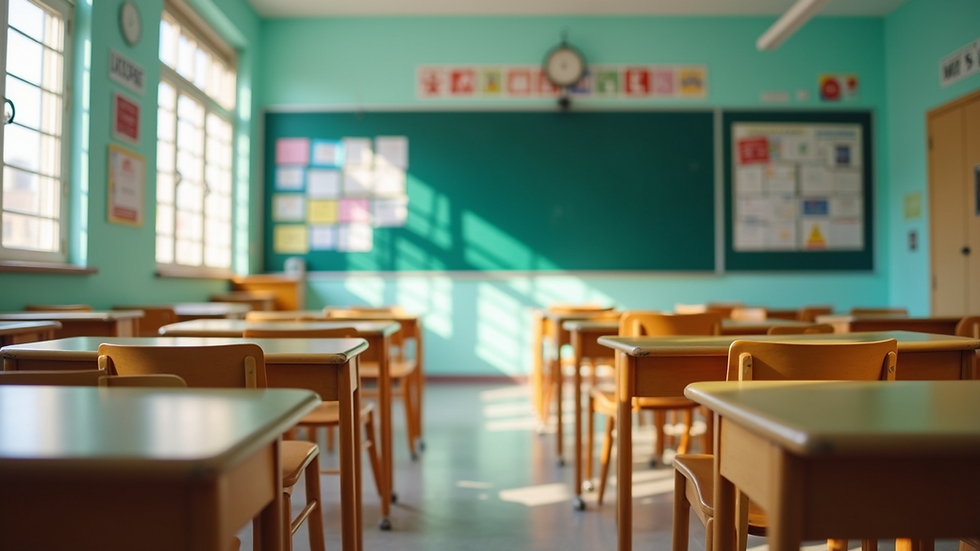Navigating the Classroom: Essential Preparations for Back to School Success for Educators
- Heather Burt

- Jul 5
- 7 min read
As the summer break draws to a close, anticipation for a new school year fills the air. Teachers everywhere are gearing up to create welcoming and effective learning environments for their students. Whether you are a veteran teacher stepping back into your classroom or a new educator embarking on your first year, being well-prepared can significantly impact your success. This guide offers educators a comprehensive checklist of essential preparations and items that not only smooth the transition back to school but also enhance the learning experience for students.
Planning Your Curriculum
A solid curriculum is the backbone of any successful teaching strategy. It provides a clear structure for lessons and activities, ensuring that important topics and skills are covered throughout the year.
Start by crafting a detailed syllabus that lays out essential subjects and skill sets for your students. For example, if you teach science, you might include units on ecosystems, the scientific method, and basic chemistry. Aim to include a range of teaching methods that cater to different learning styles, such as hands-on experiments, group discussions, and individual projects.
Don’t overlook assessing your students; include formative assessments through quizzes or projects to monitor their progress effectively. With a thoughtful plan in place, you’ll approach the school year with confidence and purpose.
Setting Up the Classroom
A well-organized classroom significantly boosts student engagement and learning. As you prepare your space, here are some key essentials to consider:
Furniture Arrangement: Arrange desks to promote interaction among students. For cooperative learning, cluster desks in groups of four or five. If you prefer a more traditional lecture format, keep desks in straight rows while ensuring you can still circulate easily.
Learning Materials: Stock your classroom with essential supplies like notebooks, art materials, and specific tools related to your subject area. Data shows that classrooms with readily available materials have a 30% higher student engagement rate.
Decor and Motivation: Brighten up your classroom with vibrant decor. Educational posters, student art, and a dedicated bulletin board for motivational quotes can create a stimulating environment that fosters positivity.

Establishing Classroom Rules and Culture
Creating a strong classroom culture hinges on clear expectations and norms. Collaborate with your students to establish rules that encourage respect, responsibility, and active engagement.
Here’s how to kick off this process:
Interactive Discussions: Initiate discussions during the first week where students can express what they believe respect and responsibility mean in your classroom.
Clear Guidelines: Print and display classroom rules visually so that everyone is constantly reminded of them.
Consequences and Rewards: Clearly explain how students will be rewarded for following the rules and what the consequences will be for breaking them. This clarity helps reinforce accountability.
Establishing these guidelines early sets a positive tone for the year and strengthens the student-teacher relationship.
Communicating with Parents
Strong communication with parents can play a huge role in a child’s success during the school year. Begin the year by developing a communication schedule to keep parents informed about their child’s progress.
Here are some effective strategies:
Welcome Letter: Send home a welcome letter that introduces yourself, outlines your teaching philosophy, and gives parents an overview of what to expect throughout the year.
Regular Updates: Consider providing monthly newsletters, or even a class webpage, to keep parents in the loop about events, classroom activities, and important dates.
Open House: Plan an open house event early in the year. This gives parents the chance to meet you, learn about classroom expectations, and discuss their child's needs.
This unified approach will foster a sense of community and strengthen the support network around each student.
Essential Supplies Checklist
As you gear up for the school year, refining your essential supplies list ensures you have everything you need on hand. Here is a checklist of must-have supplies for every teacher:
Classroom Supplies
BEYGORM 2 Pack Plastics Magnetic Pen Holder for Refrigerator, Dry Erase Marker Holder for Whiteboard: https://amzn.to/3TKwccd
Color Transparent Ruler Plastic Rulers - Ruler 12 inch,: https://amzn.to/46e6GDF
3 otters 200 Sheets Construction Paper, Cardstock Pack 8.5" x 11 ":
SUNEE 30 Packs Oversized Reusable Dry Erase Pocket Sleeves with 2 Rings:
EXPO Low Odor Dry Erase Markers Chisel Tip Assorted Fashion Colors 36 Count for Classroom Office & Home Use: https://amzn.to/3Tr33CG
Post-it Super Sticky Notes, Limited Edition Color Collection, 3x3 in, 15 Pads/Pack, 45 Sheets/Pad: https://amzn.to/4lCedQT
Crayola Ultra Clean Washable Broad Line Markers (12 Boxes): https://amzn.to/3GdbMp4
Dry Erase Board 9"x12"- Small 25 Classroom Mini White Boards for Students, Teachers: https://amzn.to/44tNdMr
Watercolor Paint Set for Kids (8 Colors), 24 Pack Washable: https://amzn.to/4lpf0os
Elmer's Disappearing Purple School Glue Sticks Washable 7 Grams 60 Count:
Crayola Colored Pencils Classpack (240ct): https://amzn.to/4klriND
Colored Masking Tape - 6 Color Masking Tape Rolls - 990 Feet x 1 Inch Painters Tape: https://amzn.to/3TlalYy
KMUYSL 200 Count Washable Markers Bulk, 10 Assorted Colors: https://amzn.to/4lDOzeE
24 Pack Privacy Folders for Students, Testing Dividers for Classroom Waterproof Plastic Privacy Shields Board: https://amzn.to/4exlkaV
Instructional Resources
Teacher Stamps for Grading Classroom,: https://amzn.to/4nxl8g0
32 Pack Number Line Dry Erase White Board Double Sided Classroom Must Haves Mat: https://amzn.to/4eAqyCZ
Fidget Toys Sensory Stone for Kids: https://amzn.to/44sBhKV
Learning Resources Answer Buzzers - Set of 4, Ages 3+,: https://amzn.to/402xqTy
100 Pack Colored Sentence Strips for Teacher Supplies: https://amzn.to/4nyLnTl
Bernhard Products Black Wall Clock Silent Non Ticking 10 Inch: https://amzn.to/3Tpcvq8
Humble Crew 4-Tier Kids Bookshelf, Natural Wood/White: https://amzn.to/3ItekQo
Personal Supplies
300 Pcs Binder Clips, Rubber Bands, Office Set, Paper Clips: https://amzn.to/4nuNCXX
ONEDONE Punch Cards (Pack of 200) Reward Punch Cards for Classroom Behavior Incentive Awards for Kids: https://amzn.to/4eyNLpb
Hadley Designs 16 Educational Posters for Classroom & Kindergarten:
Marbrasse Desk Organizer with File Holder, 5-Tier Paper Letter Tray Organizer:
Really Good Stuff 4-Compartment Caddies - Boho, 6 Pack - Classroom Organization:
60 Feet Pixel Style Bulletin Board Borders Scalloped Border Trim: https://amzn.to/3G8Wzp2
Aodaer 6 Rolls 390 Ft Glitter Bulletin Board Borders Set Colorful Scalloped Rolled Border Trim: https://amzn.to/3G8Xrdi
ThinkTex 26 Pockets Accordion File Organizer, Upright & Open Top, A-Z Colorful Tabs: https://amzn.to/4ks2Eej

Engaging Students from Day One
The first day is critical for setting a positive tone for the entire year. It’s your chance to create an environment where students feel seen and valued. Here are some activities you can implement to engage students:
Icebreakers: Use icebreaker activities that encourage students to share their interests. Simple games or fun questions can dramatically reduce first-day anxiety.
60 PCS Magnetic Building Tiles Kids Toys STEM Magnetic Blocks Sensory Toys:
Dinosaur Coloring Tablecloth & Giant Poster for Kids 30x72 Inch:
LovesTown 209 PCS Shapes Wooden Pattern Blocks for Kids: https://amzn.to/3Gp7xH2
Interactive Introductions: Have students introduce themselves by sharing their hobbies or favorite subjects. This fosters a sense of community from day one.
The Interactive Class: Using Technology to Make Learning More Relevant and Engaging in the Elementary Classroom: https://amzn.to/44wS8fx
Goal Setting: Ask students to write down their academic goals for the year. Displaying these goals in the classroom not only personalizes their space but also motivates them to strive for achievement.
These activities will create a warm and inviting atmosphere that encourages student participation.
Technology: Preparing for the Digital Classroom
Integrating technology into your teaching is no longer optional; it is essential. Preparing yourself and your students to use technology effectively can make a significant difference in the classroom.
Consider these actionable steps:
Familiarize Yourself with Tools: Take time to learn about the technology you plan to use, including learning management systems or interactive tools. Many schools report improved student performance—by as much as 20%—when technology is effectively integrated into the classroom.
Training Sessions: Schedule training sessions to help students get comfortable with any new tools. Make it interactive, allowing for questions and discussion.
Digital Etiquette: Teach lessons on responsible digital citizenship to help students navigate online interactions safely.
With proper preparation, you can help make the transition to a tech-driven educational experience seamless and effective.
Building a Supportive Network
No educator should feel they have to navigate this journey alone. Building a supportive network can enhance both your teaching and your overall experience.
Here’s how to create this community:
Connect with Colleagues: Foster relationships with fellow teachers and staff. Sharing resources, and best practices can open new pathways for improvement and student success.
Professional Development: Participate in workshops, seminars, and courses to keep up with the latest educational trends and strategies. Many teachers who actively engage in professional development see an increase in student engagement and comprehension.
Join Educator Groups: Explore local or online educator communities. Engaging with wider educator networks can inspire new ideas and provide a platform for discussing challenges.
Creating this tapestry of support will ultimately enrich your teaching experience.

Prioritizing Self-Care and Mindfulness
As an educator, your focus often shifts to your students, leaving your own self-care neglected. Maintaining your well-being is crucial to staying energized and passionate throughout the year.
Here are some self-care strategies:
Mindfulness Practices: Incorporate mindfulness exercises into your routine. Simple meditation or breathing exercises can help reduce anxiety and improve focus.
Set Boundaries: Clearly define your working hours to protect personal time. Having dedicated time for yourself or hobbies outside of school is vital.
Seek Support: Reach out for help whenever needed. Whether through friends, family, or professional support services, having a support system is essential to maintaining mental health.
By prioritizing your well-being, you position yourself to better support and inspire your students.
Looking Ahead to a Successful School Year
Preparing for a new school year can seem daunting, but with the right attitude and resources, you can navigate this transition smoothly. By crafting a cohesive curriculum, establishing a welcoming classroom culture, and fostering effective communication with parents, educators lay the foundation for a thriving learning environment.
Additionally, a well-planned supply list, engaging first-day activities, and thoughtful technology integration further enrich classroom dynamics. Alongside these efforts, building a supportive network and prioritizing self-care will help you maintain enthusiasm and drive throughout the academic year.
Teaching is a journey full of both challenges and rewards. With thoughtful preparation, you can create an enriching experience not just for your students, but for yourself as well. Here's to a successful school year ahead!



Comments